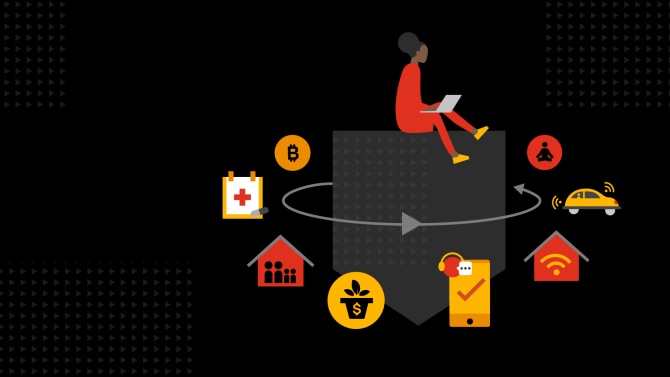{{item.title}}
{{item.text}}

{{item.text}}
Many leaders in the insurance business are confronted by the question of how to prepare for a potentially disrupted future. A new report from PwC outlines the main trends affecting the global industry going forward and adaptive ways for it to respond. But will the study findings and recommendations be of any help if you’re an insurer in Switzerland?
Insurance is often seen as risk-averse and slow to change. But accelerated in part by the pandemic, the industry is now undergoing a transformation. A new study by PwC Global, Insurance 2025 and Beyond, assesses the main forces likely to drive insurers’ growth in the coming years and proposes five strategic imperatives for them to consider as they embark on the next phase of their development.
The main growth drivers identified in the report are a widening trust gap in an uncertain world; rapidly evolving customer needs and preferences; an increasingly digital and AI-driven world; climate risks and a focus on sustainability; convergence, collaboration and competition.
The authors propose a five-pronged response insurers could consider adopting. It entails going on the offensive with digital, embracing customer-centric ecosystems, embedding ESG in the organisation’s core, winning the race for talent, and putting a premium on execution.
But which of these recommendations, if any, are relevant if you’re an insurance leader in Switzerland? At the risk of being blunt, insurers in this country have it pretty good. The business still runs along traditional lines and generates high margins in most areas. Nevertheless, in our conversations with clients we’re hearing concerns. Leaders are wondering how to prepare for potential disruption. And they’re uncertain as to what transformation will involve in terms of measures that are concrete, real and value-adding. A good starting point is to explore two questions: What does a lean model that will hold up to disruption look like? What concrete measures can I take to transform my organisation on the basis of modern technology that allows digitalisation, automation and customer-centricity?
In the light of these two questions and our conversations with insurers in Switzerland, let’s take a more detailed look at the five recommendations, assess their relevance and urgency, and try to gauge where the industry in this country really stands.
... by engaging in digital ecosystems, building customer intelligence, building products and services to meet the demands of a digital world, disrupting your distribution, re-engineering the value chain as a set of digital services, and adopting a digital mindset.
Insurance companies in Switzerland are in general less far down the digital path than their peers in other Central European countries and are still in the process of enhancing their core technology. Recently there has been a slightly closer focus in this country on front-end solutions, and insurers have also started to rethink the overall set-up and balance of their distribution channels. But to really achieve true customer centricity, ultimately they’re going to have to realise that redesigning customer journeys and customer experience involves full front-to-back integration.
In a nutshell, the Swiss industry has a fair bit of catch-up potential in terms of digital if it wants to prosper in the long run.
... by reimagining customer value, picking your spot and aligning capabilities, building a network of trusted partners, designing for digital collaboration, and aligning the operating model for multi-nodal value creation.
A number of key players in the Swiss market have already started focusing on building ecosystems around mobility, home and living as well as specific customer segments such as SMEs. While some of these initiatives are pretty far advanced, there is still insufficient proof that they’re economically viable and profitable. Business cases are looking to shift towards-fee based income revenue streams, but these efforts are still in their infancy, and there is still no firm evidence that customers will be willing to pay for these services.
One of the challenges is that ecosystems are often not orchestrated by insurers themselves, but rather by brands such as Mercedes with great emotional appeal that are embedding insurance products and attaching them to their own product. There is a risk that insurance brands will become marginalised and lose relationships with their customers.
So again, customer-centric ecosystems are on the Swiss industry’s radar, but there’s still a lot of work to be done to get up to speed.
... by elevating the understanding of ESG in your organisation, making social responsibility a core ethos of your purpose, embedding ESG in business strategy and making ESG actions and results transparent.
While environmental, social and governance considerations are high on the agenda on a very broad front in the Swiss sector, many insurers are still at an early stage in terms of defining how best to report on ESG. Given that ESG covers so many dimensions of an insurance company’s business, from supply, demand and distribution to asset management and the insurer’s own targets, it can be difficult to know where to start.
What insurers need to do is focus on implementing real actions and start the process of educating their own employees to get them behind their ESG strategy. Again, because ESG is so broad, it affects employees in different areas of the business (underwriting, marketing, distribution, finance and asset management) very differently and can be a challenging topic to get to grips with.
This is another area where there’s still plenty of potential for Swiss insurers to tap.
... by redefining the future of work, harnessing the power of culture, upskilling your workforce for the new world, taking advantage of the gig economy, and rewriting your human resources playbook.
In Switzerland insurers also face the challenge of finding the right talent to fill their capability gaps. The trouble is that having long been seen as operating in a very traditional but stable industry, they’re finding it difficult to find talent to innovate, drive and test new ideas and concepts.
The new generation of innovative talent tends to also be very purpose-driven. The fact that the insurance industry plays a crucial role in Swiss society and has the very noble purpose of helping people and companies to actually grow and protect them and their employees is potentially very appealing. The problem is that insurers haven’t yet found a good way of communicating this purpose effectively to a broader audience to change perceptions of the industry overall.
The fact is that insurers have a lot to offer in areas such as data, knowledge and risk, which are all highly attractive fields for data scientists, innovators, engineers and others to work in.
The conclusion is that if insurers in this country want to sustain any growth trajectory, they’re going to have to focus on identifying skill gaps, planning their future capability needs and creating a transition and change plan.
... by building an outcome-oriented organisation, building a strong change-management capability, establishing a transformation management organisation, and adopting an agile delivery model.
This is another area in which Switzerland is lagging overall. An agile organisation will be key for insurers going forward. Admittedly agile delivery is somewhat limited to specific areas, but even taking this into consideration it’s not yet broadly applied across the insurance market in this country. Some companies have made leaps forward, while others are still behind. It’s a similar story when it comes to change management: on the whole organisations have not yet given it high priority and are failing to address change management from the start of each project or programme.
So execution is another area where Swiss insurers could be doing a lot more to harness the available potential.
Given the strong position of insurance companies in Switzerland compared with their peers in many other places around the world, the process of adapting to pre-empt disruption and prepare for the future in this country is likely to be evolutionary rather than revolutionary. Insurers want to make necessary changes without disrupting the parts of their business that are running very well, and the areas they choose to tweak will depend very much on their individual circumstances and aspirations.
Chances are that not all the points raised in this article will be relevant to your business at present. To reiterate what we said earlier in this post, a good starting point is to consider two questions: What does a lean model that will hold up to disruption look like? What concrete measures can I take to transform my organisation on the basis of modern technology that allows digitalisation, automation and customer-centricity? If you’d like to discuss these or any other questions in more depth, feel free to reach out.
With a spotlight on purpose, trust and transformation, the evolution of the industry in the coming years will be significant for all the players in the insurance ecosystem.
#social#
{{item.text}}

{{item.text}}



